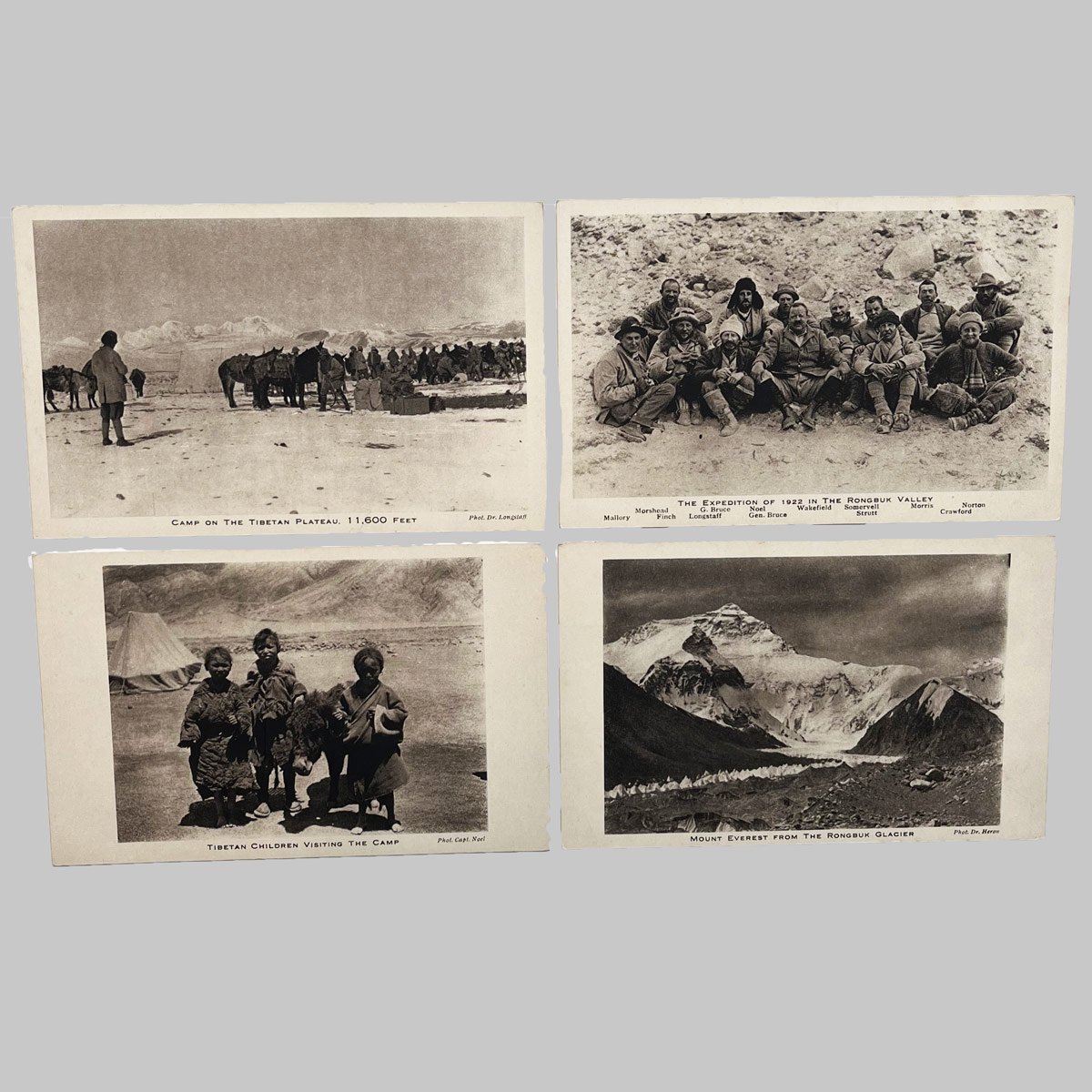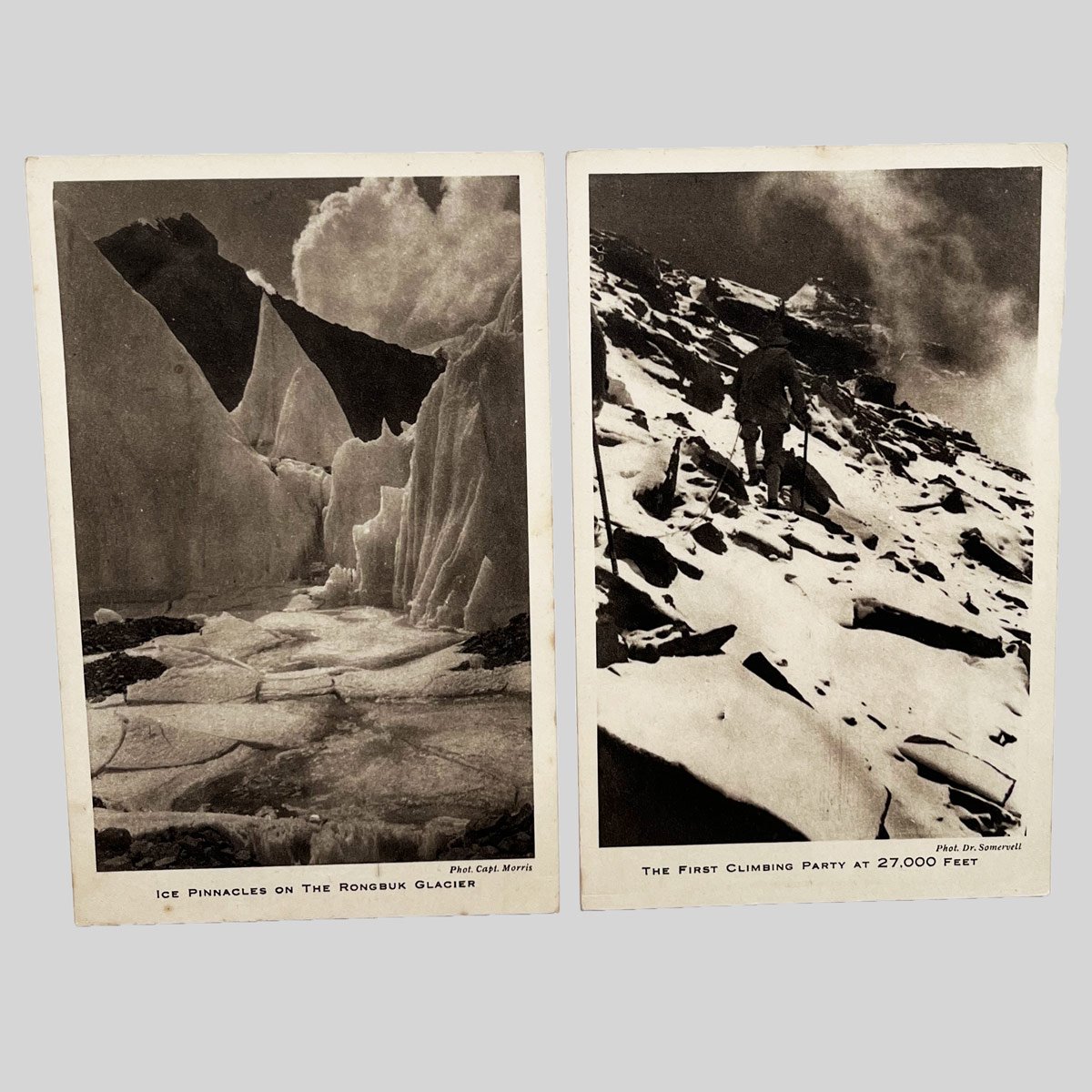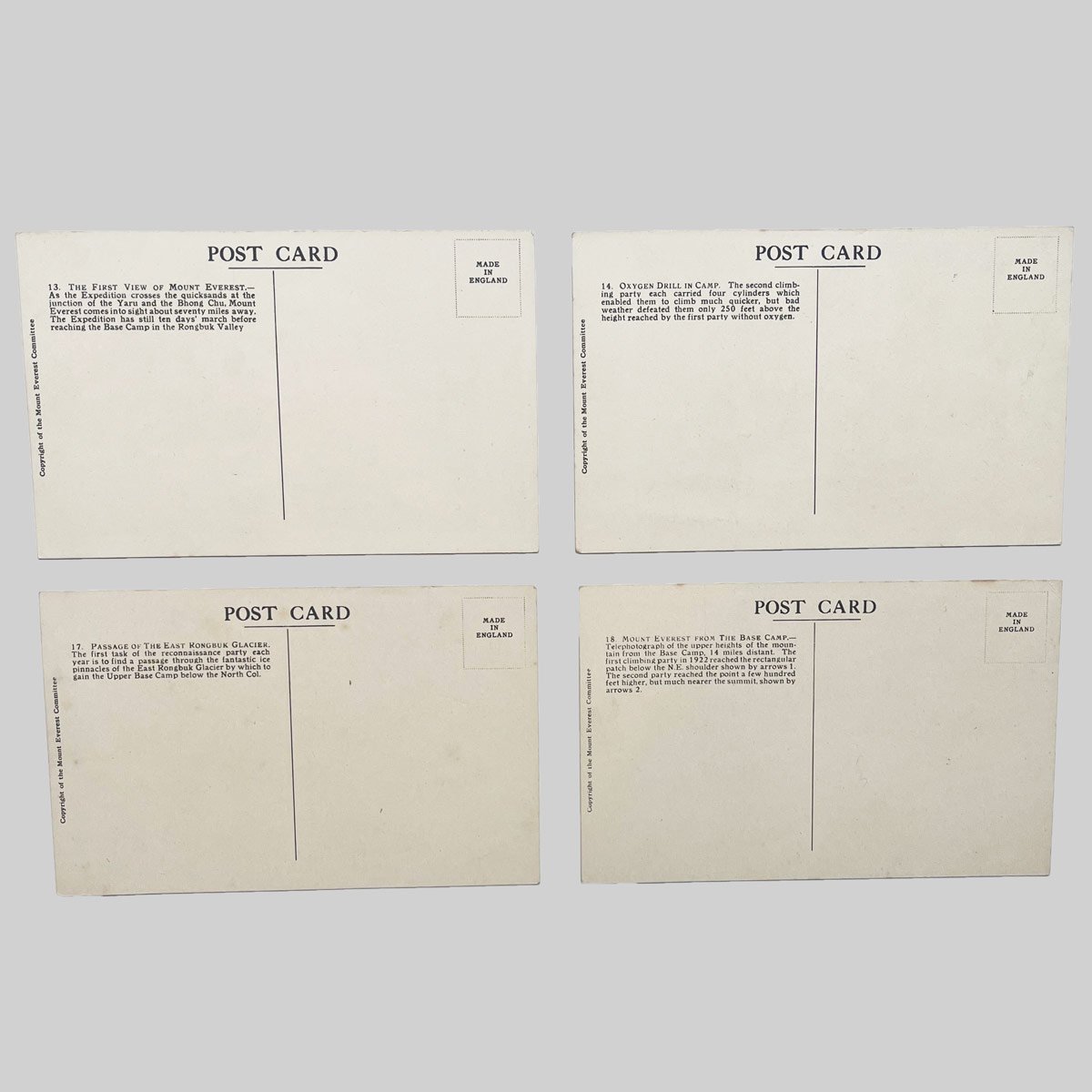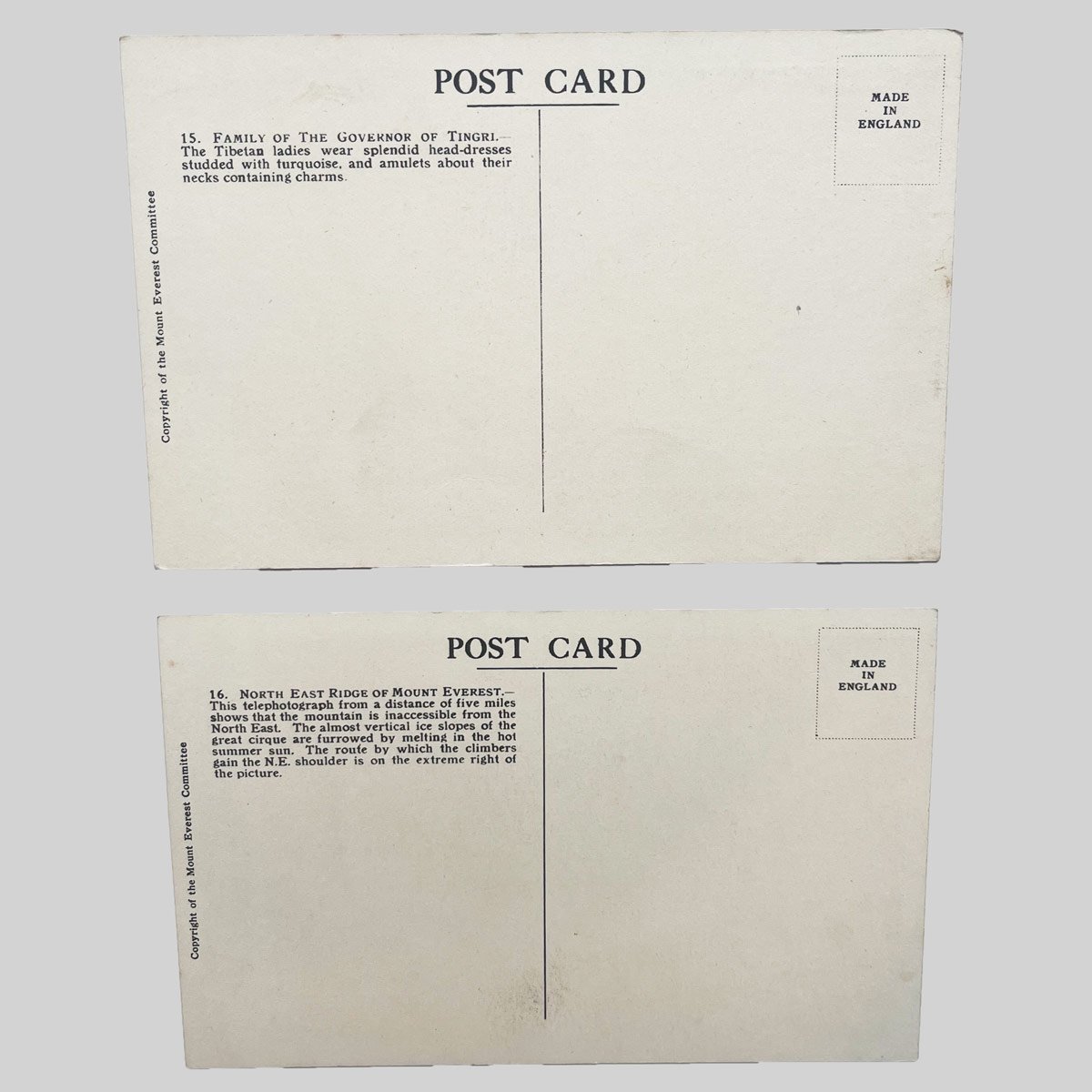 Image 1 of 13
Image 1 of 13

 Image 2 of 13
Image 2 of 13

 Image 3 of 13
Image 3 of 13

 Image 4 of 13
Image 4 of 13

 Image 5 of 13
Image 5 of 13

 Image 6 of 13
Image 6 of 13

 Image 7 of 13
Image 7 of 13

 Image 8 of 13
Image 8 of 13

 Image 9 of 13
Image 9 of 13

 Image 10 of 13
Image 10 of 13

 Image 11 of 13
Image 11 of 13

 Image 12 of 13
Image 12 of 13

 Image 13 of 13
Image 13 of 13














Postcards Of Photographs Taken By The Members Of The 1922 Everest Expedition.
18 postcards, numbered 1-18, with descriptions to verso of each, 90 x 140mm or vice versa. Printed in 1923 by the Mount Everest Committee.
The photographers were Wollaston, Howard-Bury, Noel and Somervell and the subjects include scenes of Everest, the Rongbuk monastery and glacier, various camps, Tibetan children, oxygen drill, group of the members of the expedition including Mallory, and "the highest photograph ever taken" at c.27,000ft, of the summits of the North Peak and Gyachung Khan, both below the photographer. A notable and interesting record of one of the key periods of Mountaineering history.
The postcards are in fine condition.
“The 1922 British Mount Everest expedition was the first mountaineering expedition with the express aim of making the first ascent of Mount Everest. This was also the first expedition that attempted to climb Everest using bottled oxygen. The expedition would attempt to climb Everest from the northern side out of Tibet. At the time, Everest could not be attempted from the south out of Nepal, as the country was closed to Western foreigners. The 1921 British Mount Everest reconnaissance expedition had explored the whole eastern and northern surroundings of the mountain. In searching for the easiest route, George Mallory, who was also to be a member of the 1924 expedition (and the only person on all three expeditions in 1921, 1922 and 1924), had discovered a route which, in his opinion, would allow an attempt on the summit. After two unsuccessful summit attempts, the expedition ended on the third attempt when seven Nepalese porters died as the result of a group-induced avalanche. Not only had the expedition failed to reach the summit, but it also marked the first reported climbing deaths on Mount Everest. The expedition did however establish a new world record climbing height of 8,326 metres (27,320 ft) during their second summit attempt, which was subsequently exceeded in the 1924 expedition.” (dbpedia org)
Postcard 1. “Eastern Spurs Of Mount Everest. The Expedition of 1921 found that there is no hope of ascending Mount Everest by its eastern spurs, which descend by steep ice cliffs into the deep Kama Valley beyond the nearer peak.”
Postcard 2. “The Governor Of Kharta And His Wife, who hospitably entertained both Expeditions on their visit to the Kharta Valley.”
Postcard 3. “The Rongbuk Monastery And Mount Everest. The valley which forms the route to Mount Everest from the north is specially sacred, and many pilgrims come annually to the Monastery which is 16 miles from Mount Everest and lies at a height of 16,500 feet, or 1,500 feet higher than Mont Blanc.”
Postcard 4. “Ice Caverns On The Rongbuk Glacier. The glaciers of Mount Everest are worn into fantastic ice pinnacles by the rapid melting and evaporation in the fierce sun and dry air, and the glacier streams cut magnificent caverns.”
Postcard 5. “Camp 4 On The North Col. This camp at 23,000 feet is the point from which the ascent is made by the steep slopes to the North East shoulder and then away to the right to the summit which is outside the picture. The first climb in 1922 reached 26,985 feet, close to the N.E. shoulder.”
Postcard 6. “The Highest Photograph Ever Taken. The first climb in 1922 without oxygen reached close to 27,000 feet and from this point Mr T. H. Somervell took the photograph showing the summit of the North Peak, 24,550 feet, well below on the right, and Gyachung Kang, 25,990 feet, well below the horizon towards the left.”
Postcard 7. “Camp On The Tibetan Plateau, 11,600 feet. The Expedition arrives on the plateau in early spring, and the first marches are over the bitter windswept plains. During the 20 days’ march on the high plateau the mountaineers become acclimatised.”
Postcard 8. “The Expedition Of 1922 In The Rongbuk Valley. The members of the first high climbing party in 1922 were Mallory, Norton, Somervell and Morshead, and the second party, Finch, Geoffrey Bruce and Corporal Tejbir. General Bruce is again in command in 1924, and has with him Norton, Mallory, Somervill, Geoffrey Bruce and Noel of the 1922 Expedition, with six new members.”
Postcard 9. “Tibetan Children Visiting The Camp. The people of Tibet are most friendly to the Expedition, and pay continual visits to the Camps while the expedition is on its long march across the plateau to the base of the mountain.”
Postcard 10. “Mount Everest From The Rongbuk Glacier. The main Rongbuk Glacier leads to the inaccessible northwestern face of the mountain. The route to the summit is by the East Rongbuk Glacier beyond the hills to the left of the picture. The highest point yet reached on the mountain is exactly behind the summit of the North Peak which lies in front of Mount Everest.”
Postcard 11. “Ice Pinnacles On The Rongbuk Glacier. The rapid melting and evaporation of the glacier in the fierce sun and dry air produces the ice pinnacles 100 feet high which thrust themselves up from the stones which cover a great part of the glacier.”
Postcard 12. “The First Climbing Party At 27,000 Feet. The northern face of the mountain is composed of rough rock slabs sharply tilted and lightly covered with snow which is blown into clouds by the terrific winds. Only the last few hundred feet of the summit seem likely to present real climbing difficulties, but the bitter wind and rarefied air make the ascent most formidable.”
Postcard 13. “The First View Of Mount Everest. As the Expedition crosses the quicksands at the junction of the Yaru and the Bhong Chu, Mount Everest comes into sight about seventy miles away. The Expedition has still ten days’ march before reaching the Base Camp in the Rongbuk Valley.”
Postcard 14. “Oxygen Drill In The Camp. The second climbing party each carried four cylinders which enabled them to climb much quicker, but bad weather defeated them only 250 feet above the height reached by the first party without oxygen.”
Postcard 15. “Family Of The Governor Of Tingri. The Tibetan ladies wear splendid head-dresses studded with turquoise, and amulets about their necks containing charms.”
Postcard 16. “North East Ridge Of Mount Everest. This telephotograph from a distance of five miles shows that the mountain is inaccessible from the North East. The almost vertical ice slopes of the great cirque are furrowed by melting in the hot summer sun. The route by which the climbers gain the N.E. shoulder is on the extreme right of the picture.”
Postcard 17. “Passage Of The East Rongbuk Glacier. The first task of the reconnaissance party each year is to find a passage through the fantastic ice pinnacles of the East Ronbgbuk Glacier by which to gain the Upper Base Camp below the North Col.”
Postcard 18. “Mount Everest From The Base Camp. Telephotograph of the upper heights of the mountain from the Base Camp, 14 miles distant. The first climbing party in 1922 reached the rectangular patch below the N.E. shoulder shown by arrows 1. The second party reached the point a few hundred feet higher, but much nearer the summit, shown by arrows 2.”
Please contact us for shipping costs if ordering from outside the UK.
18 postcards, numbered 1-18, with descriptions to verso of each, 90 x 140mm or vice versa. Printed in 1923 by the Mount Everest Committee.
The photographers were Wollaston, Howard-Bury, Noel and Somervell and the subjects include scenes of Everest, the Rongbuk monastery and glacier, various camps, Tibetan children, oxygen drill, group of the members of the expedition including Mallory, and "the highest photograph ever taken" at c.27,000ft, of the summits of the North Peak and Gyachung Khan, both below the photographer. A notable and interesting record of one of the key periods of Mountaineering history.
The postcards are in fine condition.
“The 1922 British Mount Everest expedition was the first mountaineering expedition with the express aim of making the first ascent of Mount Everest. This was also the first expedition that attempted to climb Everest using bottled oxygen. The expedition would attempt to climb Everest from the northern side out of Tibet. At the time, Everest could not be attempted from the south out of Nepal, as the country was closed to Western foreigners. The 1921 British Mount Everest reconnaissance expedition had explored the whole eastern and northern surroundings of the mountain. In searching for the easiest route, George Mallory, who was also to be a member of the 1924 expedition (and the only person on all three expeditions in 1921, 1922 and 1924), had discovered a route which, in his opinion, would allow an attempt on the summit. After two unsuccessful summit attempts, the expedition ended on the third attempt when seven Nepalese porters died as the result of a group-induced avalanche. Not only had the expedition failed to reach the summit, but it also marked the first reported climbing deaths on Mount Everest. The expedition did however establish a new world record climbing height of 8,326 metres (27,320 ft) during their second summit attempt, which was subsequently exceeded in the 1924 expedition.” (dbpedia org)
Postcard 1. “Eastern Spurs Of Mount Everest. The Expedition of 1921 found that there is no hope of ascending Mount Everest by its eastern spurs, which descend by steep ice cliffs into the deep Kama Valley beyond the nearer peak.”
Postcard 2. “The Governor Of Kharta And His Wife, who hospitably entertained both Expeditions on their visit to the Kharta Valley.”
Postcard 3. “The Rongbuk Monastery And Mount Everest. The valley which forms the route to Mount Everest from the north is specially sacred, and many pilgrims come annually to the Monastery which is 16 miles from Mount Everest and lies at a height of 16,500 feet, or 1,500 feet higher than Mont Blanc.”
Postcard 4. “Ice Caverns On The Rongbuk Glacier. The glaciers of Mount Everest are worn into fantastic ice pinnacles by the rapid melting and evaporation in the fierce sun and dry air, and the glacier streams cut magnificent caverns.”
Postcard 5. “Camp 4 On The North Col. This camp at 23,000 feet is the point from which the ascent is made by the steep slopes to the North East shoulder and then away to the right to the summit which is outside the picture. The first climb in 1922 reached 26,985 feet, close to the N.E. shoulder.”
Postcard 6. “The Highest Photograph Ever Taken. The first climb in 1922 without oxygen reached close to 27,000 feet and from this point Mr T. H. Somervell took the photograph showing the summit of the North Peak, 24,550 feet, well below on the right, and Gyachung Kang, 25,990 feet, well below the horizon towards the left.”
Postcard 7. “Camp On The Tibetan Plateau, 11,600 feet. The Expedition arrives on the plateau in early spring, and the first marches are over the bitter windswept plains. During the 20 days’ march on the high plateau the mountaineers become acclimatised.”
Postcard 8. “The Expedition Of 1922 In The Rongbuk Valley. The members of the first high climbing party in 1922 were Mallory, Norton, Somervell and Morshead, and the second party, Finch, Geoffrey Bruce and Corporal Tejbir. General Bruce is again in command in 1924, and has with him Norton, Mallory, Somervill, Geoffrey Bruce and Noel of the 1922 Expedition, with six new members.”
Postcard 9. “Tibetan Children Visiting The Camp. The people of Tibet are most friendly to the Expedition, and pay continual visits to the Camps while the expedition is on its long march across the plateau to the base of the mountain.”
Postcard 10. “Mount Everest From The Rongbuk Glacier. The main Rongbuk Glacier leads to the inaccessible northwestern face of the mountain. The route to the summit is by the East Rongbuk Glacier beyond the hills to the left of the picture. The highest point yet reached on the mountain is exactly behind the summit of the North Peak which lies in front of Mount Everest.”
Postcard 11. “Ice Pinnacles On The Rongbuk Glacier. The rapid melting and evaporation of the glacier in the fierce sun and dry air produces the ice pinnacles 100 feet high which thrust themselves up from the stones which cover a great part of the glacier.”
Postcard 12. “The First Climbing Party At 27,000 Feet. The northern face of the mountain is composed of rough rock slabs sharply tilted and lightly covered with snow which is blown into clouds by the terrific winds. Only the last few hundred feet of the summit seem likely to present real climbing difficulties, but the bitter wind and rarefied air make the ascent most formidable.”
Postcard 13. “The First View Of Mount Everest. As the Expedition crosses the quicksands at the junction of the Yaru and the Bhong Chu, Mount Everest comes into sight about seventy miles away. The Expedition has still ten days’ march before reaching the Base Camp in the Rongbuk Valley.”
Postcard 14. “Oxygen Drill In The Camp. The second climbing party each carried four cylinders which enabled them to climb much quicker, but bad weather defeated them only 250 feet above the height reached by the first party without oxygen.”
Postcard 15. “Family Of The Governor Of Tingri. The Tibetan ladies wear splendid head-dresses studded with turquoise, and amulets about their necks containing charms.”
Postcard 16. “North East Ridge Of Mount Everest. This telephotograph from a distance of five miles shows that the mountain is inaccessible from the North East. The almost vertical ice slopes of the great cirque are furrowed by melting in the hot summer sun. The route by which the climbers gain the N.E. shoulder is on the extreme right of the picture.”
Postcard 17. “Passage Of The East Rongbuk Glacier. The first task of the reconnaissance party each year is to find a passage through the fantastic ice pinnacles of the East Ronbgbuk Glacier by which to gain the Upper Base Camp below the North Col.”
Postcard 18. “Mount Everest From The Base Camp. Telephotograph of the upper heights of the mountain from the Base Camp, 14 miles distant. The first climbing party in 1922 reached the rectangular patch below the N.E. shoulder shown by arrows 1. The second party reached the point a few hundred feet higher, but much nearer the summit, shown by arrows 2.”
Please contact us for shipping costs if ordering from outside the UK.
18 postcards, numbered 1-18, with descriptions to verso of each, 90 x 140mm or vice versa. Printed in 1923 by the Mount Everest Committee.
The photographers were Wollaston, Howard-Bury, Noel and Somervell and the subjects include scenes of Everest, the Rongbuk monastery and glacier, various camps, Tibetan children, oxygen drill, group of the members of the expedition including Mallory, and "the highest photograph ever taken" at c.27,000ft, of the summits of the North Peak and Gyachung Khan, both below the photographer. A notable and interesting record of one of the key periods of Mountaineering history.
The postcards are in fine condition.
“The 1922 British Mount Everest expedition was the first mountaineering expedition with the express aim of making the first ascent of Mount Everest. This was also the first expedition that attempted to climb Everest using bottled oxygen. The expedition would attempt to climb Everest from the northern side out of Tibet. At the time, Everest could not be attempted from the south out of Nepal, as the country was closed to Western foreigners. The 1921 British Mount Everest reconnaissance expedition had explored the whole eastern and northern surroundings of the mountain. In searching for the easiest route, George Mallory, who was also to be a member of the 1924 expedition (and the only person on all three expeditions in 1921, 1922 and 1924), had discovered a route which, in his opinion, would allow an attempt on the summit. After two unsuccessful summit attempts, the expedition ended on the third attempt when seven Nepalese porters died as the result of a group-induced avalanche. Not only had the expedition failed to reach the summit, but it also marked the first reported climbing deaths on Mount Everest. The expedition did however establish a new world record climbing height of 8,326 metres (27,320 ft) during their second summit attempt, which was subsequently exceeded in the 1924 expedition.” (dbpedia org)
Postcard 1. “Eastern Spurs Of Mount Everest. The Expedition of 1921 found that there is no hope of ascending Mount Everest by its eastern spurs, which descend by steep ice cliffs into the deep Kama Valley beyond the nearer peak.”
Postcard 2. “The Governor Of Kharta And His Wife, who hospitably entertained both Expeditions on their visit to the Kharta Valley.”
Postcard 3. “The Rongbuk Monastery And Mount Everest. The valley which forms the route to Mount Everest from the north is specially sacred, and many pilgrims come annually to the Monastery which is 16 miles from Mount Everest and lies at a height of 16,500 feet, or 1,500 feet higher than Mont Blanc.”
Postcard 4. “Ice Caverns On The Rongbuk Glacier. The glaciers of Mount Everest are worn into fantastic ice pinnacles by the rapid melting and evaporation in the fierce sun and dry air, and the glacier streams cut magnificent caverns.”
Postcard 5. “Camp 4 On The North Col. This camp at 23,000 feet is the point from which the ascent is made by the steep slopes to the North East shoulder and then away to the right to the summit which is outside the picture. The first climb in 1922 reached 26,985 feet, close to the N.E. shoulder.”
Postcard 6. “The Highest Photograph Ever Taken. The first climb in 1922 without oxygen reached close to 27,000 feet and from this point Mr T. H. Somervell took the photograph showing the summit of the North Peak, 24,550 feet, well below on the right, and Gyachung Kang, 25,990 feet, well below the horizon towards the left.”
Postcard 7. “Camp On The Tibetan Plateau, 11,600 feet. The Expedition arrives on the plateau in early spring, and the first marches are over the bitter windswept plains. During the 20 days’ march on the high plateau the mountaineers become acclimatised.”
Postcard 8. “The Expedition Of 1922 In The Rongbuk Valley. The members of the first high climbing party in 1922 were Mallory, Norton, Somervell and Morshead, and the second party, Finch, Geoffrey Bruce and Corporal Tejbir. General Bruce is again in command in 1924, and has with him Norton, Mallory, Somervill, Geoffrey Bruce and Noel of the 1922 Expedition, with six new members.”
Postcard 9. “Tibetan Children Visiting The Camp. The people of Tibet are most friendly to the Expedition, and pay continual visits to the Camps while the expedition is on its long march across the plateau to the base of the mountain.”
Postcard 10. “Mount Everest From The Rongbuk Glacier. The main Rongbuk Glacier leads to the inaccessible northwestern face of the mountain. The route to the summit is by the East Rongbuk Glacier beyond the hills to the left of the picture. The highest point yet reached on the mountain is exactly behind the summit of the North Peak which lies in front of Mount Everest.”
Postcard 11. “Ice Pinnacles On The Rongbuk Glacier. The rapid melting and evaporation of the glacier in the fierce sun and dry air produces the ice pinnacles 100 feet high which thrust themselves up from the stones which cover a great part of the glacier.”
Postcard 12. “The First Climbing Party At 27,000 Feet. The northern face of the mountain is composed of rough rock slabs sharply tilted and lightly covered with snow which is blown into clouds by the terrific winds. Only the last few hundred feet of the summit seem likely to present real climbing difficulties, but the bitter wind and rarefied air make the ascent most formidable.”
Postcard 13. “The First View Of Mount Everest. As the Expedition crosses the quicksands at the junction of the Yaru and the Bhong Chu, Mount Everest comes into sight about seventy miles away. The Expedition has still ten days’ march before reaching the Base Camp in the Rongbuk Valley.”
Postcard 14. “Oxygen Drill In The Camp. The second climbing party each carried four cylinders which enabled them to climb much quicker, but bad weather defeated them only 250 feet above the height reached by the first party without oxygen.”
Postcard 15. “Family Of The Governor Of Tingri. The Tibetan ladies wear splendid head-dresses studded with turquoise, and amulets about their necks containing charms.”
Postcard 16. “North East Ridge Of Mount Everest. This telephotograph from a distance of five miles shows that the mountain is inaccessible from the North East. The almost vertical ice slopes of the great cirque are furrowed by melting in the hot summer sun. The route by which the climbers gain the N.E. shoulder is on the extreme right of the picture.”
Postcard 17. “Passage Of The East Rongbuk Glacier. The first task of the reconnaissance party each year is to find a passage through the fantastic ice pinnacles of the East Ronbgbuk Glacier by which to gain the Upper Base Camp below the North Col.”
Postcard 18. “Mount Everest From The Base Camp. Telephotograph of the upper heights of the mountain from the Base Camp, 14 miles distant. The first climbing party in 1922 reached the rectangular patch below the N.E. shoulder shown by arrows 1. The second party reached the point a few hundred feet higher, but much nearer the summit, shown by arrows 2.”
Please contact us for shipping costs if ordering from outside the UK.
